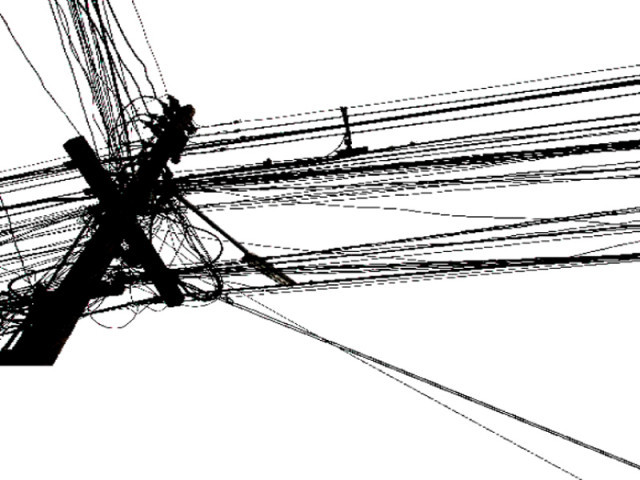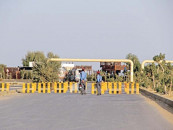Living near high tension electric wires
Hanging power cables around the city create an ugly face, present danger to residents and passersby.

Living near high tension electric wires
Electricity wires hanging down in clusters from electrical poles, passing through houses or lying on the street is not a very pleasant sight. A casual look at many of the streetlight poles or electricity poles in the city will always reveal such ugly scenes. Despite many cases of electrocution every year, the Islamabad Electric Supply Company (IESCO) seems least bothered with addressing the problem.
During Monday’s spell of rain, high voltage electricity cables in many parts of the city sunk dangerously low, drooping to ground level and posing a danger to residents nearby. Many electricity poles were seen slanting.
The snare of wires not only mars the area’s face, but also keeps our hearts racing in fear, says Rana Nadeem, a resident of Bhabra Bazaar, an architectural heritage zone.
The residents and city managers of Rawalpindi have come to ignore this ugly trap of wires as these same wires carry electricity to thousands of small basement shops and offices in dark alleys where even sunlight and fresh air cannot penetrate.
But every so often, this pretence of innocuousness is exposed. Not long ago, an IESCO worker was electrocuted when he was working on a wet pole during a downpour on Asghar Mall Road. Even last year, a pedestrian was electrocuted at the turn towards Pirwadhai Bus Stand on IJ Principal Road after a live wire dropped on him.
Unwieldy webs of electricity wires hanging on electricity poles appear to be overlooked. Visits to several parts of Pindi city not only show sights that defy attempts at creating a visually aesthetic city, but also one that pose danger to residents.
Areas such as Bahbara Bazaar, Lunda Bazaar, Sarafa Bazaar, Moti Bazaar, Bara Bazaar, Iqbal Road, DAV College Road, Gawalmandi, Qasai Galli Pak Crockery Market, Dhok Najoo and Kashmiri Bazaar, are just a few of such places where heavy webs of electricity wires dot the roads.
Apart from the visual irritant created by the clutter of electricity wires, they also pose a danger to human lives. This is because many of the wires feebly hang off heavy-laden poles and as a result, their weight pulls them earthwards. At times, they fall off the hook and hurt passersby.
Asif Khan, a resident of Railway Colony, Loi Bher, said that until recently, all the connections on his street were illegal. “I had to cry out to Railway authorities to avoid a case of electrocution.” The connections were done on an electricity pole on Salahuddin Avenue and transmitted to buildings in Railway Colony. Sparks often emanated from them and the wires were resting on the roofs of some buildings in the area, he added.
There are several cases of illegal strings of connections resulting in a web on the road running through Faisal Town to Gangal Town and Gulzar-e-Quaid to Airport Housing Society and Judicial Colony. Also, some specific cases on the Airport Link Road route are Tajabad, Shah Khalid Colony, Dhok Hafiz and Chungi No 11, where poles are entangled with disjointed cables.
While episodes of electrocution are mainly restricted to the rainy season, fires ensuing from short circuits are a recurring dilemma. The number of electricity wires keeps growing with increasing demand. Every day, a new business enterprise opens, and with it the power load also goes up. There have been some occurrences of transformer fires inside the markets due to short-circuiting, says Akbar Hussain, who runs a garment store in Commercial Market, Satellite Town.
IESCO does not even cover the main power boxes. Hawkers display their goods on them. An accident is waiting to happen, says, Haider Ali, the owner of a general store on Saidpur Road.
Traders claim they had informed IESCO of the slanting electricity poles and naked live wires issues, but IESCO officers told them that they were unable to do anything as they lacked funds.
Published in The Express Tribune, September 22nd, 2012.


















COMMENTS
Comments are moderated and generally will be posted if they are on-topic and not abusive.
For more information, please see our Comments FAQ